Nazi flags wanted
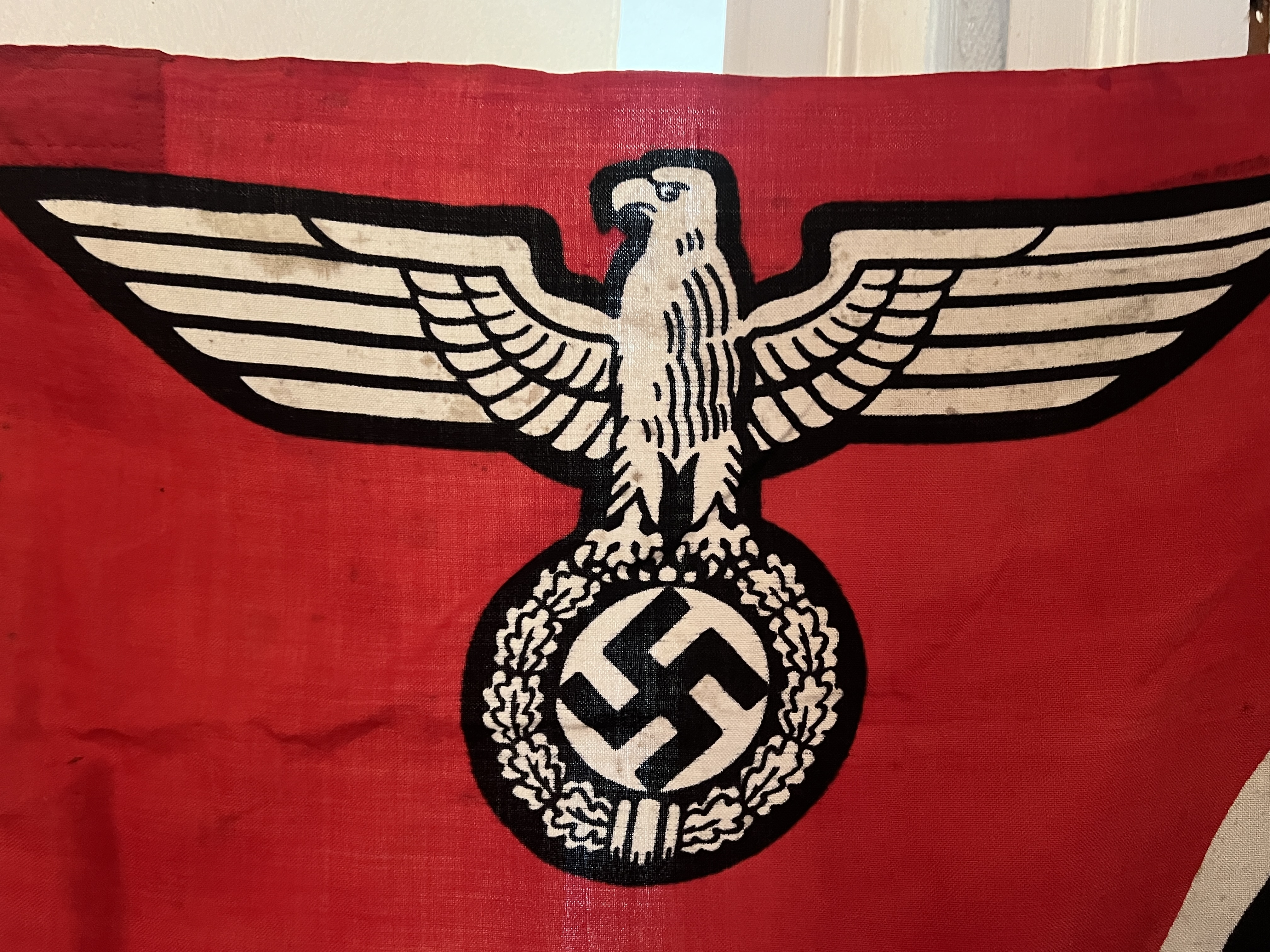
Overview of site about authentic Nazi flags
Introduction as to why a site about Nazi flags is required
Contact German Flags
Types of Nazi flags
Types of Nazi pennants
Types of Nazi armbands
Examples of Nazi banner tops
Nazi flag-related badges
Care and storage of Nazi flags
Nazi flags in the news
External Militaria-related Links
References
Introduction
This site was established in order to help people who find that they have inherited a Nazi flag and are wondering what to do with it. It is also an advisory to collectors to consider storing their flags in archive-quality materials. The information presented, is off the bat so to speak, and based on decades of experience, but some references are given to collectors' literature and a few original Third Reich sources.
Flags produced during the Third Reich era are now around 80 years old, and the condition of some flags can be quite poor, with most being subject to moth at the very least. It is probably now the time that a re-assessment of how Third Reich era flags are displayed/stored/bought/sold occurs. Ideally, they should be housed in museums and given their proper historical context. They lost much of this context when they made their way onto the collectors' market, especially as flags were bought and sold without documentation as to their previous owners (ie soldier who originally brought them back from the war). As such, these flags have become dis-possessed commodities in the marketplace. Ironically, the drive to make a profit has often taken centre stage rather than historical inquiry. When
flags enter the market, there is often no precise details or documentation as to where and when the flags were originally acquired. These flags were a significant war trophy for those who captured them. This history is now often lost, or vague at best.
Flags and banners were instrumental in the Nazi's rise to power and their subsequent grip on German society. Flags, armbands and pennants had a function during the Weimar Republic and the Third Reich, and were an integral part of the Nazi power structure. By there very nature they are offensive to Holocaust survivors and victims of Hitler's regime. Moves are already afoot in Australia to completely ban the trade in Nazi artefacts. The trade has not done itself any favours, with profit being put over the concerns of Holocaust survivors and their families. With so many original Nazi flags in circulation or yet to be found, something needs to be done about them. Museums (the ideal place) will not always take Nazi flags, and many online marketplaces prohibit their sale. As stated earlier, they are now around 80 years old and often quite fragile.
People who have Nazi flags should consider storage and regard them as archive-quality historical objects rather than display backdrops. There seems to be less emphasis on collecting and preservation compared to profit or the word investment that is often bandied about. The case in Australia is worth mentioning in this regard. Under the proposed law, collectors will still be able to keep what they have gathered, they will just not be able to buy and sell more. Infringements on private property aside (ie the collectors bought the items when they were legal, and will not be compensated), such legislation separates out the profiteers from collectors who value their collection for its historical value.
Short of being destroyed, or subject to the ravages of time, Nazi flags will outlive us. It is uncertain, at the present time, where the flags will end up. They, should, however be de-commodified as much as possible. In this spirit, prices have not been included on this website. Retail prices of Nazi flags do seem inflated, with a wide variation of prices for similar flags by various people offering them for sale. This website is not a sale's site and none of the flags are offered for sale. An indication has been given, however, as to the general availability of similar flags on the market.
Large volumes of flags were produced during the Third Reich with most Nazi organisations and the military having distinct emblems, flags and pennants. With a few exceptions, most types of Nazi flags can be obtained. If people have moral qualms about selling an inherited flag, they could donate the funds raised to a charity that would benefit others. in-fact we have acquired flags in this way. Perhaps this is a stop gap at the moment, especially in the UK where the trade is currently legal. Contrary to press reports, it is not currently illegal to buy/sell Nazi artefacts in Germany (it is their public display that is an offence). Nazi items can be bought/sold for educational purposes, although it is possible that the trade will be prohibited at some point.
BACK TO OVERVIEW
Contact
If you have discovered a Nazi flag, then please get in touch and tell us as much as possible about it. Please don't send email attachments/pictures at this initial stage.
In order to reduce our spam you will need to type our email address into your mail package manually. The start of our email address is:
tyskflags
Followed by @ then gmail.com
Please always put Flag Info in the subject line as it is more likely to get answered.
BACK TO OVERVIEW
Types of original Nazi flags
Only half of the flags have been displayed.
Battle flag

An example of a
Nazi Battle flag, Reich War flag.
Established 1935 to replace the Imperial war flag. Tilted swastika in centre, Iron Cross top left hand corner. Flag background has Balkan cross design. Red/white/black. Printed onto cotton/linen. Halyard band usually stamped. Used by all branches of the Wehrmacht, army, navy and airforce). If naval, will often be stamped with an eagle above an M. Sizes range from around 50cm by 85cm to over 200 by 335cm. Standard size is usually about 80cm by 135cm. Collectors prefer smaller flags to the larger flags that are more difficult to display/store. Usually has reinforcing stitching and panels. Often size-marked on the band. and has rope. Generally available and collectors of Third Reich artefacts would usually have at least one example at some point.
STATE Service flag

An example of a
Nazi Service flag, Reich service flag.
Flown on administrative buildings but also used by the Kriegsmarine (ie barge boats). If latter, flag will usually be stamped with the naval proof mark (see above). Printed onto cotton/linen. Usual red/white/black. Static central swastika within disc. Eagle and swastika (tilted) at top left hand corner. Doubled sided as per above. Sizes similar to battle flags, as well as prices. Usually has reinforcing stiching and panels. Often size-stamped on the band and has rope. Similar availability to the battle flag above.
NSDAP flag

An example of a
German national flag (Nazi Germany), or NSDAP, Nazi party flag.
Became the national German flag from late 1935 onwards, following the flag incident in New York harbour. Also known as the national flag or the house flag (Hausefahne). Construction can vary from all printed examples to entirely multi-piece or a variation of. Typical size flown outside a house is 80cm by 125cm. Collectors generally prefer smaller flags (not huge drapes). Smaller flags usually have the red material looped round for the pole. In many respects, images of the Nazi era are dominated by this style of basic flag displayed in streets. Collectors will typically have a version of this flag in their collections, and they are not considered scarce. Rich colour and condition are important, and their is more on condition in a later section on this website.
Harbour pilot flag

These flags were flown on tug boats that guided ships into port, as such a highly functional flag. Cotton/linen. White/cream background with printed black swastika within a red rectangle. Halyard is usually size stamped with the addition of the Kriegsmarine proof mark of an eagle above an M. Also often has metal hooks attached to the rope. Constructed in a similar way to battle flags, with panels and reinforcing stitching. The one pictured is small (50 by 65cm) but they also came in larger sizes. Collectors often don't know what these flags are, and the white/cream background tends to detract from the flags impact (compare this flag to the party flag pictured above). Harbour flags are obtainable and prices are a lot less than battle or state service flags, and perhaps more in line with a standard party flag.
Early SA static swastika flag

The style of the swastika on this multi-piece constructed flag is the static type ie not tilted. It also has the earlier style of clips rather than rings. It has one patch in the upper left hand corner to an SA water station batallion, surrounded by a metal wire border. Probably dates from around 1933/34 or before. These flags would be considered scarce
DAF flag

German Labour Front. headed by Dr Robert Ley, formed 1933. Multipiece construction with swastika within cog and area/company patch in top left hand corner. Complete with all its metal rings (which are often RZM stamped, Reich equipment supplier). Usual red/white/black. One of the most available of the parade flags. DAF was a huge organisation.
NSKOV flag

National Socialist War Widows and Orphans Association. Iron Cross with central swastika within circle. Printed onto cotton. Usual red/white/black. Not encountered as much as battle flags, but prices are a lot less, as there is not much demand amongst collectors for NSKOV items.
BACK TO OVERVIEW
Types of original Nazi pennants
As the emblems on the pennants are relatively small and less in your face, entire examples have been pictured.
Army officers car pennant

Grey cotton cloth with embroidered eagle, double sided, with protective cover. One of the more available Wehrmacht car pennants.
kriegsmarine officers car pennant

Blue with bright yellow double sided embroidered eagle. Generally scarcer than the army pennant.
Luftwaffe officers car pennant

Grey with double sided embroidered flying eagle. Generally scarcer compared to standard army or naval pennants.
DDAC car pennant (German Automobile Association)

Associations eagle with swastika. Red/white/black. Similar in nature to present-day motoring organisations, although no organisation during the Third Reich could be considered immune from Nazi ideology, especially as Jews were banned from driving/owing cars after the Night of Broken Glass, 1938. As the DDAC is deemed a civillian organisation, collectors have less interest compared to the Wehrmacht, and prices generally reflect this. They also seem to be readily available on the collectors' market.
BACK TO OVERVIEW
Types of original Nazi armbands
Only half of most armbands have been displayed.
NSDAP/SA (Nazi party/Brown Shirts armband)

Worn on the standard brown shirt. Multi-piece. Red melton-style cloth. Red/white/black. Some examples are printed, or have a seperate white disc and black printed swastika. Generally available.
SS armband

Worn on the black SS jacket (Just think of the classic Hollywood Nazi in Indy Jones and the Last Crusade). Similar to the standard Nazi-party style armband but with addition of two horizontal black borders. Multipiece. Complete with RZM label. Red/white/black. These armbands are highly reproduced. Original example shown. SS armbands are considered quite scarce, as are most original SS items. Pic still to be uploaded.
SA (Brown Shirts) sport's armband
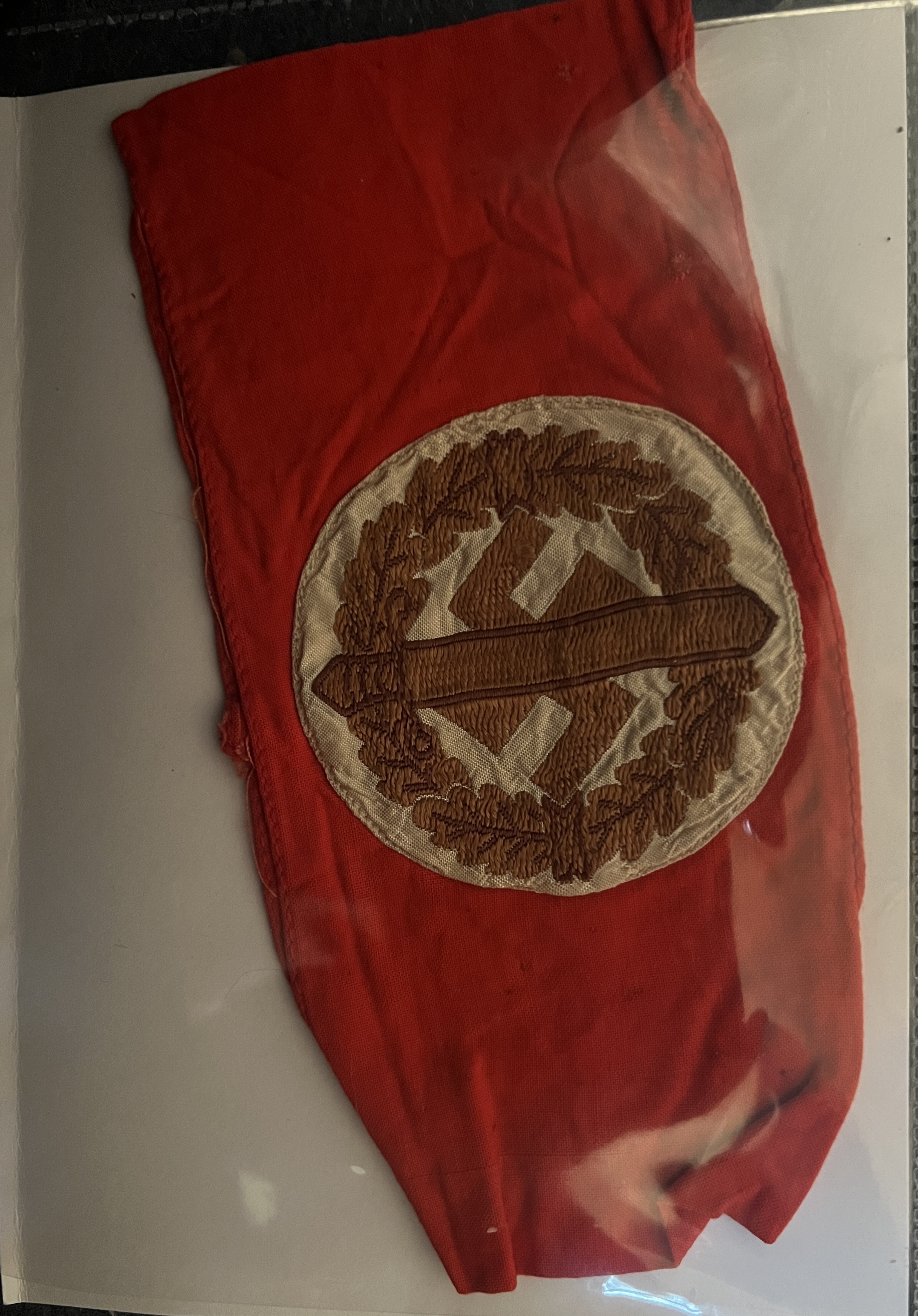
Worn by sport's leaders involved in the qualification for the SA sport badge. Gold-coloured embroidered version of this badge woven onto white disc sewn onto red cotton band. Scarcer than standard Nazi-party armband, but not a huge deal of interest in these armbands amongst collectors.
Hitler Youth (HJ) armband
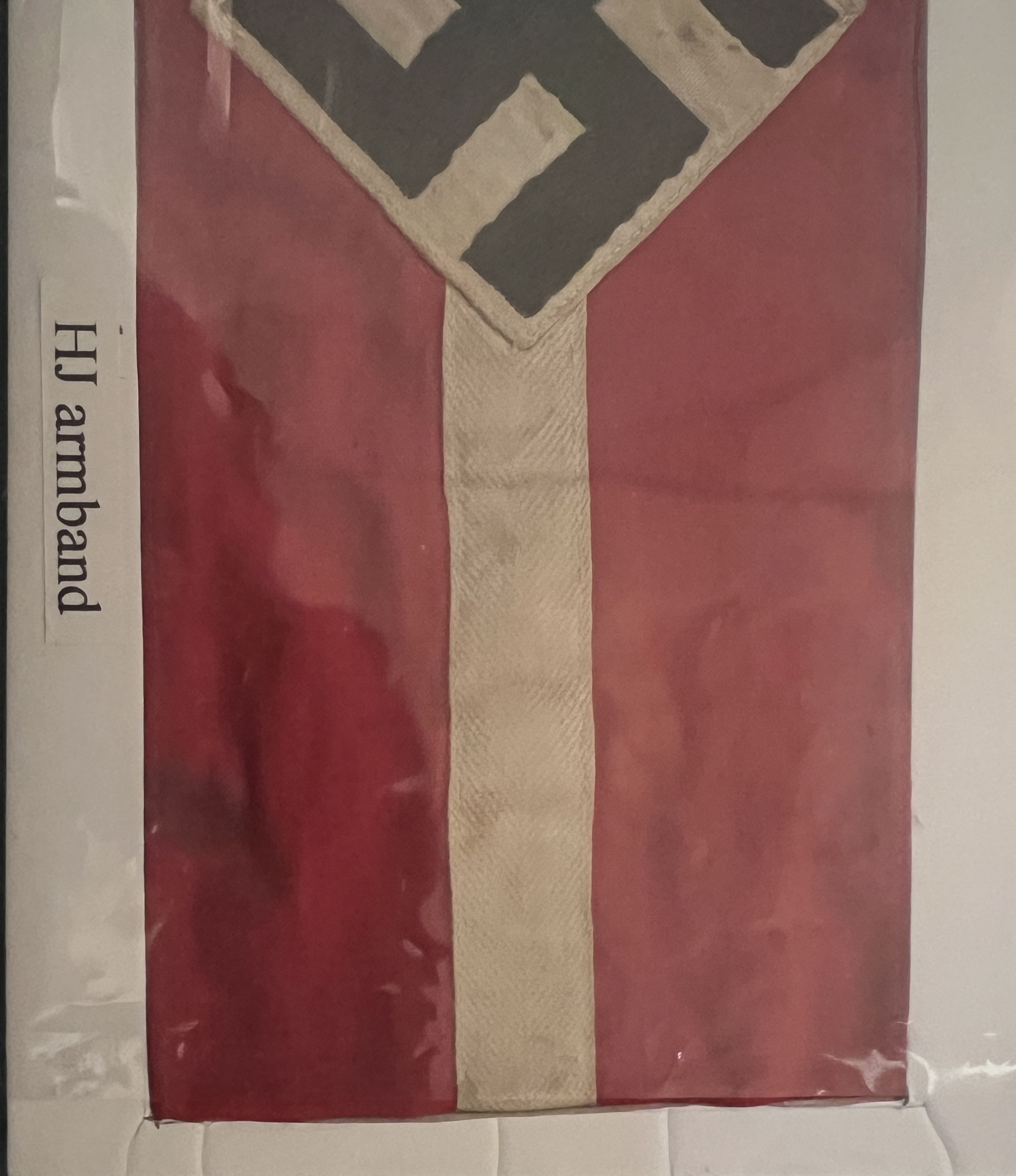
White/cream HJ diamond with black swastika and central horizontal band on red background. Most often of multi-piece construction. Membership of the HJ was compulsory from 1937. Readily available.
HJ armbands are featured in Angolia (1991, p182).
Volkssturm armband

German Home Guard formed in late 1944. Print on narrow cotton band. Red/white/black. Germany's last-ditch defence efforts are of historical interest, and this armband is a tactile reminder of how even at a late stage in the war, resources were still given to insignia. Scarcer than standard Nazi-party armbands, although as the Volkssturm is not as popular amongst collectors, prices are somewhat less. Pic still to be uploaded.
State service armband
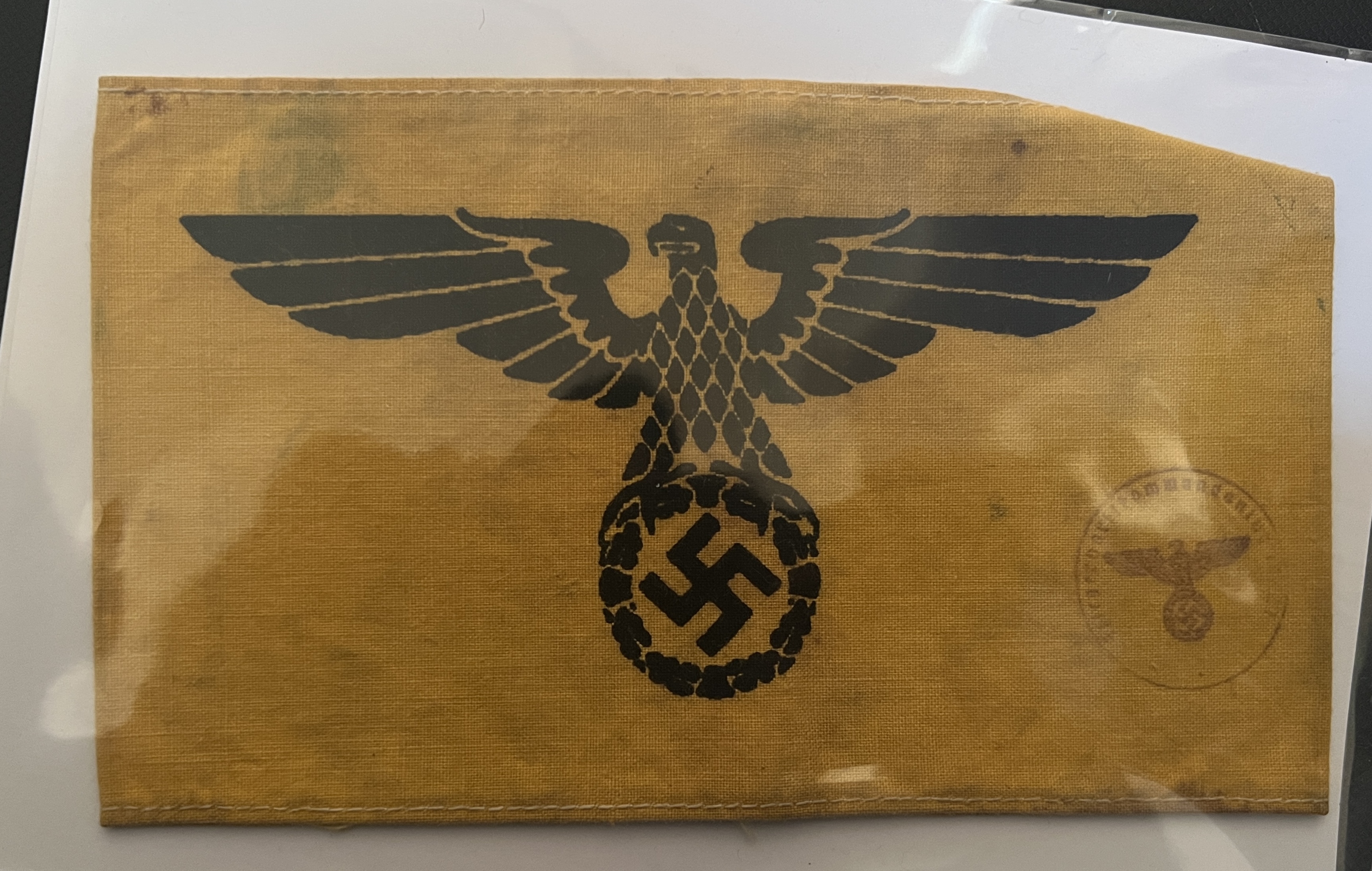
Yellow cotton with black eagle and swastika. A variation has a white band. Often appear on the market.
National Socialist War Veteran's Association armband
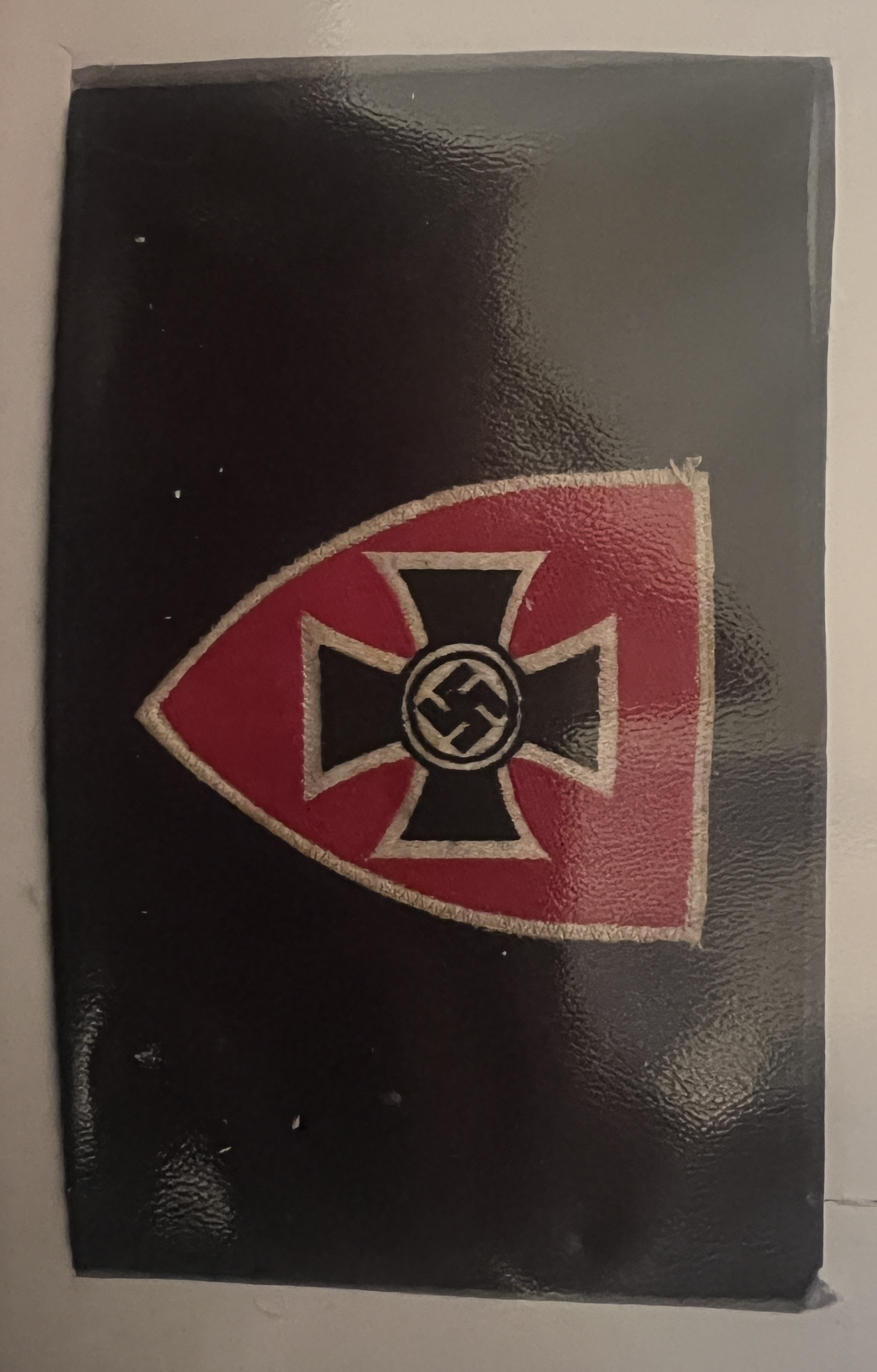
Features a dark-blue blue woolen band with superimposed shield with an Iron Cross and swastika. Organisation included veterans of the First World War, and was an attempt to Nazify veteran's associations. Obtainable.
BACK TO OVERVIEW
Examples of original Nazi banner tops
NSBO banner top
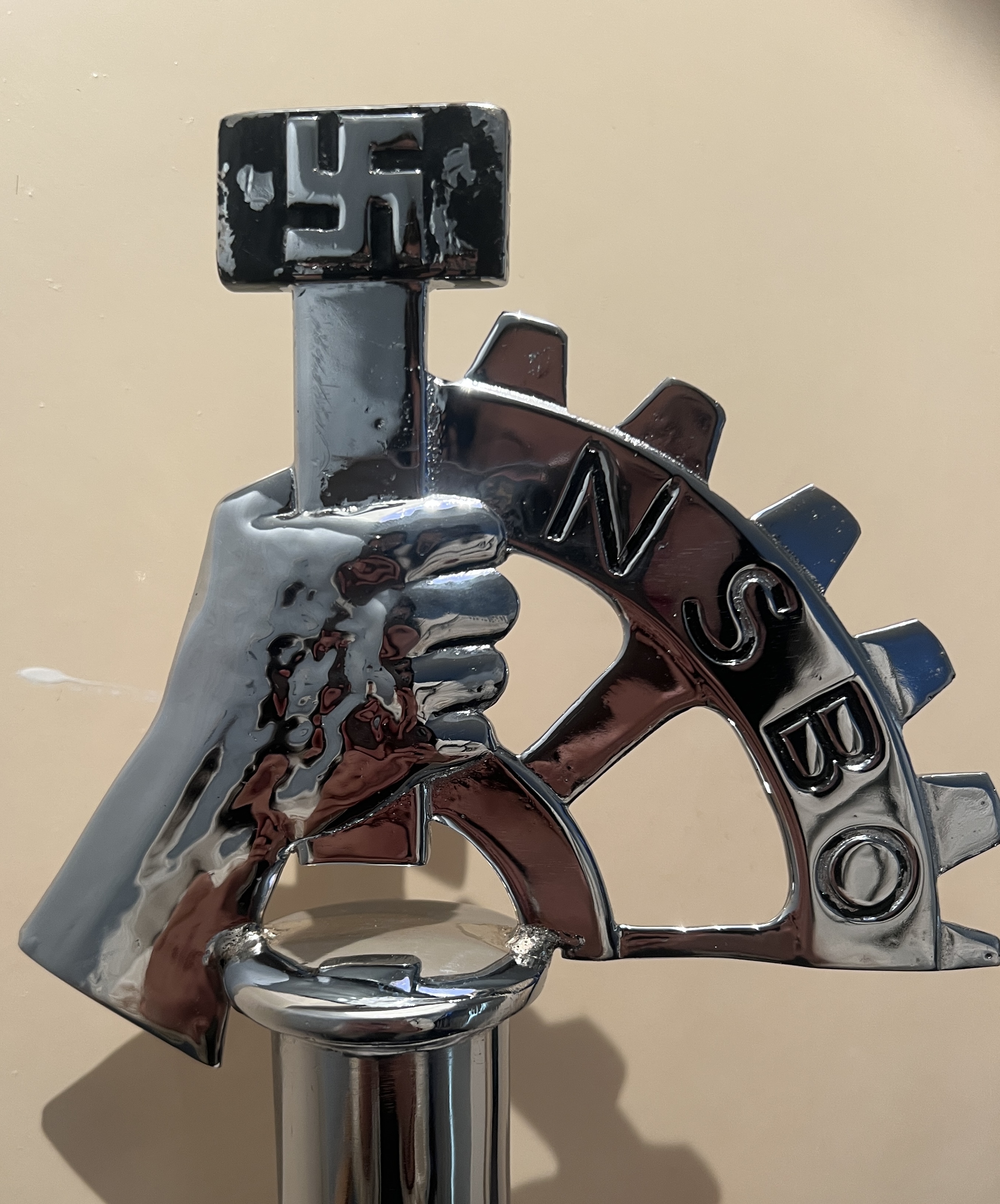
National Socialist Factory-Cell Association. Forerunner to the DAF. Heavy nickle. This example has no maker stamps. Banner tops are highly reproduced, which has put off collectors. Prices can vary significantly depending on the banner top in question and its condition. Examples to the NSBO and DAF are more available.
An NSBO banner top is featured in Walker (1973).
German Veteran's Association

No maker stamps. Collectors don't pay much attention to veteran's associations and prices tend to reflect this.
BACK TO OVERVIEW
Examples of original Nazi flag-related badges
Nazi Weimar rally anniversary 1926-1936

Features the Deutschland Erwache standard. Rally commemorates ten years since the rally held in Weimar, 1926. Flag standards first introduced in 1923. It was these flags that Hitler touched with the Nazi's so-called Blood Flag at their annual rally. Deutchland Erwache Roman/church-style banners, although a hallmark of Nazi rallies were presumably destroyed at the end of the war, taken by Soviet forces, and are rare. Day badges have a wide variation in price and represent one of the more accessible forms of Nazi memorabilia, and perhaps even more historically interesting than many combat badges. Pic still to be uploaded.
BACK TO OVERVIEW
Care and storage of authentic Nazi flags
Flags are like Gremlins, they don't like sunlight or getting wet.
The classic red/white/black is a striking combination and was used to its maximum effect during both the Weimar Republic and the Third Reich. If one is to understand the pull of the Nazi flag today, it is important that the colour of these flags are as close to what they were when they were displayed. The colour red in the flag was deemed blood red, although shades/tones do vary depending on the maker. A collector/museum has no control over the way in which flags were displayed during the Third Reich or after the war. They can, however help to preserve them so that future generations may understand the Nazi past. Flags that surface today are usually mothed (sometimes badly), torn or ripped in places, faded, fragile, and have heavy fold marks/creases. Whilst we are not conservators, flags should not be stored square but rolled if they can not be stored flat. They should also be wrapped in acid-free sheets then ideally rolled over an archive-quality tube, protected by an archive-quality outer sleeve then placed in an archive-quality tube/box. This might seem excessive, but poor storage decisions made today will affect how future generations experience and obtain understanding from the flags. Perhaps it is because Nazi flags are relatively obtainable that collectors don't seem to pay too much attention to their storage; from the dealer who stuffs a pile into a plastic bag to take to a Militaria fair; to the collector who tacks them onto their wall as a backdrop. Compared to flags, armbands and pennants are more managable, which is perhaps why they have proved popular amongst collectors, with examples of some pennants even exceeding the prices of flags. If we were pressed to give the most important feature of a Nazi flag, it would be the colour of red. There are many flags on the market, but many do not have a vivid colour that almost seems alive and jumps off the flag. Perhaps this is a result of a weaker dye they were originally made from or they have faded. Flags that have retained a striking colour are potentialy too historically valuable to be displayed without consideration given to how they are displayed and stored. They should also be kept in conditions that give them a chance of being protected from moth/insects/rodents. It is time that serious consideration is given to the display/storage/buying/selling of Nazi flags.
BACK TO OVERVIEW
FLAG-RELATED NEWS STORIES/WEBSITES
Inheriting a Nazi flag presents an ethical dilemma, Ottawa Citizen, 2021
What Should You Do With a Captured Nazi Flag? Atlas Obscura, 2021
German Nazi Swastika Flag, Smithsonian Institution
Nazi Party Flag, Anti-Defamation League
External Militaria-related Links
Links are presented in alphabetical order and don't constitute an endorsement.
Clicking on a link will take you away from the germanflags.co.uk website,
and all dealings with the below companies are entirely at your own risk.
Jamie Cross, mainly Third Reich badges and medals
References
Angolia, John (1991). The Hitler Youth Volume 1. California: Bender Publishing.
Walker, Andrew Stephen (1973). Flags and Banners of the Third Reich. Surrey: Almark.
BACK TO OVERVIEW
Last updated 5 April 2024, 4 November 2023





















